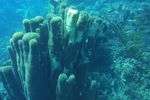First report of Stony Coral Tissue Loss Disease in the Dominican Republic
←
→
Page content transcription
If your browser does not render page correctly, please read the page content below
First report of Stony Coral Tissue Loss Disease in the Dominican Republic
Iker Irazabal1, Manuel Alejandro Rodriguez2
1
Reef Check Dominican Republic, Santo Domingo, Dominican Republic (iker@reefcheckdr.org)
2
Maguá Ecological Foundation, Sosúa, Dominican Republic
ABSTRACT: This report documents the first known instance of the Stony Coral Tissue Loss
Disease (SCTLD) in the north coast of the Dominican Republic. The disease, which currently
affects a number of territories in the Caribbean, appears to be spreading and is a cause of concern
to the scientific community and area managers across the region. The disease was observed on 3rd
March 2019 in and around the reef of Cayo Arena, near the town of Punta Rucia, Puerto Plata. The
species infected, and the pattern of infection follows what has been previously reported for the
disease.
INTRODUCTION on the species infected and the size of the
colony (NOAA, 2018).
The Stony Coral Tissue Loss Disease
(SCTLD) is an emerging new threat to SCTLD was first observed in the Dominican
Caribbean coral reefs. First reported off the Republic by the authors during a leisure
coast of Florida in late 2014, it spread along snorkeling trip on March 3rd to Cayo Arena,
the coastline reaching the Lower Keys in a popular tourist destination on the north
early 2018. By spring 2018 corals with signs coast of the island, located 9 km away from
of SCTLD were reported in Jamaica the town of Punta Rucia in the province of
(AGRRA, 2018). On July 2018 a team Puerto Plata.
reported the disease in Puerto Morelos,
MATERIALS AND METHODS
Mexico, and has been closely monitoring its
spread (Alvarez-Filip, 2018). In late 2018 the The location of Cayo Arena (19.870217°, -
disease was again reported farther away in St. 71.305558°) consists on a small (0.2km2)
Maarten and the U.S. Virgin Islands, where it sand key and a surrounding barrier reef that
has quickly spread, causing mass colony creates a shallow lagoon. There is a
mortality of up to 90% (The Daily Herald, significant difference in coral growth pattern
2018) (The Virgin Islands Consortium, between the exposed and protected sides of
2019). the reef. Inside the lagoon there is sparse
marine vegetation, with Syringodium and
As of 2019, the disease affects 20 species of fleshy algae dominating before a back reef is
scleractinian corals, with higher occurrence formed, with Palythoa caribaeorum, Porites
in massive, reef-forming species. The disease astreoides, Pseudodiploria strigosa and
causes loss of tissue, exposing the calcareous Montastraea annularis found in small
skeleton of the colonies, expanding either as colonies. Moving towards the reef crest on its
windward side, the dominant species found
a band or as a series of blotches that radiate
are Acropora palmata, Millepora spp. the,
outwards. The disease is lethal to the
Montastraea complex and P. strigosa. The
colonies, and its spread rate varies depending frontal reef ends at approximately 12 m
depth, followed by a sandy slope to deeperwaters. Healthy colonies of the Montastraea
b
complex, Acropora cervicornis (sparsely), b
Montastraea cavernosa, Porites porites, and
Agaricia agaricites are found.
While snorkeling on the reef the disease was
identified on large colonies of several species
of scleractinian corals and photographs of the
lesions were taken on breath-hold.
RESULTS
The disease was first observed affecting a
c
medium-sized Meandrina meandrites inside
the lagoon and was mis-identified as White
Plague. As the observation progressed along
the outer reef, the signs of the disease were
evident by the shape of the lesions and the
species affected (Fig. 1). Most large (>1m
Dia.) colonies of Siderastrea siderea, P.
strigosa, and a particularly large colony of
Dendrogyra cylindrus (Fig. 1c), showed d
varying degrees of infection. Smaller
colonies and recruits of said species showed
no signs of infection. Some A. palmata
showed tissue-loss lesions but cannot be
readily attributed to SCTLD.
a
Figure 1. Photographs of SCTLD in the Cayo Arena
reef. (a)Siderastrea siderea (b)Colpophyllia natans
(c) Dendrogyra cylindrus, (d) Pseudodiploria
strigosa
DISCUSSION
The disease appears to be following the same
spread pattern that was described for Florida
(NOAA, 2018), with an early onset of
infection present in large colonies of P.
strigosa, M. meandrites and D. cylindrus. S.
siderea is considered an intermediately
susceptible species but was among the first to
be infected with the disease. SCTLD has not
yet spread to the Orbicella complex or theAgaricia species that form the dominant Further surveys will be conducted in the area
cover of the reef in Cayo Arena. Based on by both organizations to follow the spread of
previous visits to the area, the onset of the the infection, and the effort should be
infection is estimated to have taken place replicated along the coastline of the
between 1-5 months prior to the elaboration Dominican Republic and Haiti by other
of this report. organizations in their respective areas of
operation.
LITERATURE CITED
AGRRA. (2018, August 14). Diseased corals in Jamaica. Retrieved from AGRRA: Atlantic and Gulf Rapid
Reef Assesment: http://www.agrra.org/front-page-news/august-update-coral-disease-
outbreak/
Alvarez-Filip, L. (2018). OUTBREAKS OF CARIBBEAN CORAL DISEASE ON THE RISE. Retrieved from BARCO
LAB: https://www.barcolab.org/copy-of-outbreak-of-caribbean-coral
NOAA. (2018). Case Definition: Stony Coral Tissue Loss Disease (SCTLD). Maryland: National Oceanic and
Atmospheric Administration.
The Daily Herald. (2018, November 25). The Daily Herald. Retrieved from Epidemic disease detected on
St. Maarten’s coral reefs: https://www.thedailyherald.sx/islands/82937-epidemic-disease-
detected-on-st-maarten-s-coral-reefs
The Virgin Islands Consortium. (2019, February 15). STONY CORAL TISSUE LOSS DISEASE SIGHTED IN ST.
THOMAS WATERS. Retrieved from The Virgin Islands Consortium:
https://viconsortium.com/virgin-islands-2/stony-coral-tissue-loss-disease-sighted-in-st-thomas-
waters/You can also read





















































